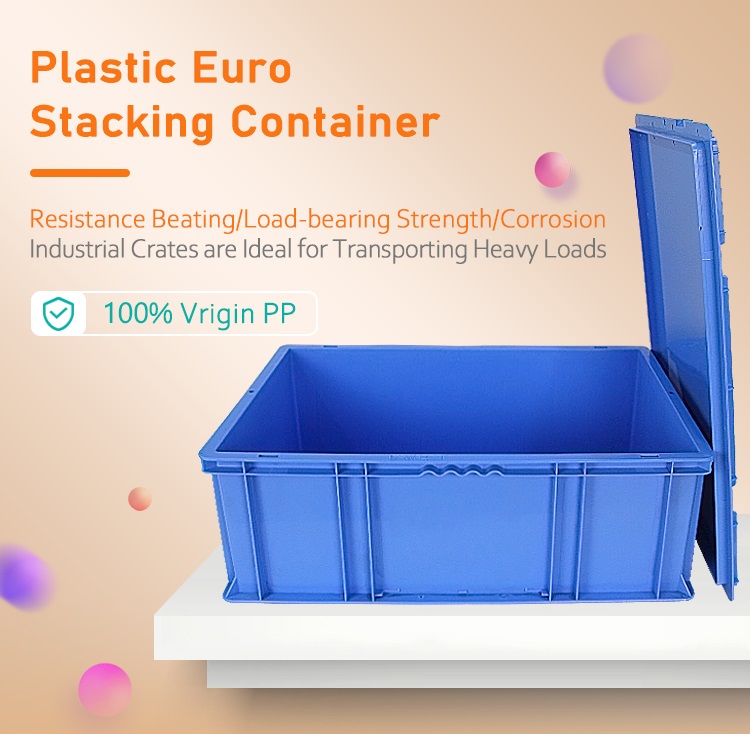Plastic stacking crates (also known as plastic turnover crates or plastic stacking baskets) are made primarily of polyethylene (PE) and polypropylene (PP). Their superior structural design and material properties make them widely used in logistics, warehouse management, and daily storage. They are a key tool for improving space utilization and optimizing operational efficiency in modern supply chains and everyday storage.
Core Advantages
1. Lightweight and Easy to Carry: With their low material density (PE/PP density is approximately 0.9-0.92g/cm³), they weigh only 1/5-1/3 of concrete or wooden crates of the same size. Even fully loaded with items (such as clothing or tools), they can be easily carried by one person. Some styles also feature side handles or curved carry handles for enhanced grip comfort and reduced handling fatigue.
2. Ultra-Durability and Durability:
*Impact Resistance: PE/PP material offers excellent toughness, resisting cracking at low temperatures (-20°C to -30°C) and deformation at high temperatures (60°C-80°C, with some heat-resistant models capable of exceeding 100°C). It withstands daily collisions and drops (from heights of 1-2 meters) with a lifespan far exceeding that of cardboard (reusable over 50 times, even for years).
*Corrosion Resistance: Non-water-absorbing and rust-resistant, resistant to acids, alkalis, oils, and chemical solvents (such as common detergents and pesticide diluents). It will not mold, rot, or corrode when in contact with damp items (such as fresh produce and alcohol) or industrial raw materials (such as hardware parts and plastic pellets).
3. Efficient Stacking and Space Utilization:
* Standardized stacking design: The box bottom and lid (or opening for lidless models) precisely match, allowing empty boxes to be “nested” (saving over 70% space) and full boxes to be “stably stacked” (typically 3-5 layers, with a load capacity of 50-100kg per layer, depending on the model), preventing tipping. This design is particularly suitable for dense stacking in warehouses and for truck transport.
* Select models feature “stacking stoppers”: These further secure the stacked boxes to prevent shifting and accommodate vibrations (such as truck transport).
4. Versatile Adaptability:
* Flexible structure: Available in models with or without lids, with or without dividers, and with wheels or fixed configurations. Choose your desired configuration (e.g., lids protect against dust and moisture, dividers organize small parts, and wheels facilitate the movement of heavy objects).
*Customizable: Supports logo printing, color changes (commonly available in black, white, blue, and red), ventilation holes (suitable for fresh produce and plants), and locks (suitable for valuables), meeting commercial or industrial customization needs.
5. Environmentally Friendly and Low-Cost:
*Environmentally Friendly Materials: Made from food-grade PE/PP, suitable for food contact (such as fruits, vegetables, and snacks), and compliant with FDA and GB 4806 safety standards, these boxes are odorless and release no harmful substances.
*Recyclable: Discarded boxes can be shredded and reprocessed for recycling, making them environmentally friendly and more environmentally friendly than disposable cardboard boxes.
*Cost-Effective: Unit prices typically range from 10-50 yuan (small to medium-sized), and they can be reused for years, with long-term costs significantly lower than cardboard boxes (which require frequent replacement) or wooden boxes (which are easily damaged and expensive).
*Easy to Clean and Maintain: The smooth surface eliminates dead corners and can be cleaned with water, a rag, or a high-pressure water jet (suitable for industrial oil-contaminated areas). It resists stains and bacteria, making it particularly suitable for applications requiring high hygiene standards, such as food and medical.
Post time: Sep-12-2025





